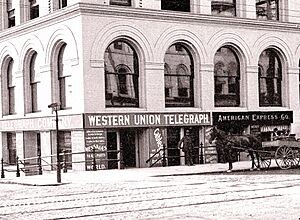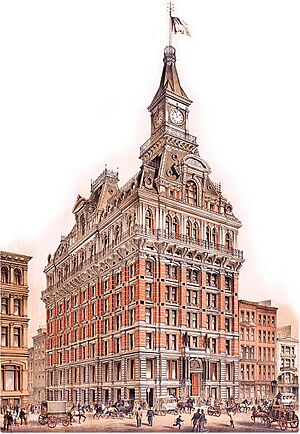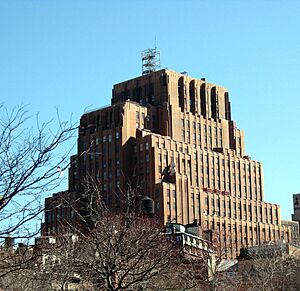Western Union facts for kids
| Public | |
| Traded as |
|
| Industry | Financial services |
| Founded | April 8, 1851 in Rochester, New York, U.S. |
| Headquarters | Denver, Colorado, U.S. |
|
Area served
|
Worldwide |
|
Key people
|
Jeffrey A. Joerres (chairman) Devin McGranahan (president and CEO) |
| Services | Wire transfers Money orders Money transfers Bill pay Transfer tracking Price estimation |
| Revenue | |
|
Operating income
|
|
| Total assets | |
|
Number of employees
|
9,000 (2018) |
The Western Union Company is an American company that helps people send and receive money around the world. Its main office is in Denver, Colorado.
The company started in 1851 in Rochester, New York, as the New York and Mississippi Valley Printing Telegraph Company. It changed its name to Western Union Telegraph Company in 1856 after joining with other telegraph companies. For many years, from the 1860s to the 1980s, Western Union was a leader in the American telegraph industry. They invented new technologies like telex and offered services such as sending money by wire, along with their main job of sending telegram messages.
In the 1980s, Western Union faced money problems. They started to focus less on communications and more on sending money. By 2006, they stopped all their communication services. At that time, The New York Times newspaper called Western Union "the world's largest money-transfer business." The company remained very important, especially for immigrants sending money home to their families.
Western Union played a big part in the history of technology. In 1861, they finished building the first transcontinental telegraph line across the United States. This helped connect the Atlantic Ocean and Pacific Ocean coasts. The very first messages sent on this line went to President Abraham Lincoln.
Contents
History of Western Union
Early Years and Growth (1851–1866)
The New York and Mississippi Valley Printing Telegraph Company was started in Rochester, New York, in 1851. Its founders included Samuel L. Selden and Hiram Sibley. In 1856, this company joined with a rival, the Erie and Michigan Telegraph Company. At the suggestion of Ezra Cornell, the combined company was renamed Western Union Telegraph Company.
In 1857, Western Union joined five other large telegraph companies in an agreement called the 'Treaty of Six Nations'. This agreement aimed to create a system where each company had a specific area to operate in, sharing a main network of telegraph lines. Western Union continued to buy other telegraph companies, both big and small. By 1864, it had become a major national company, with only a few serious competitors.
Western Union completed the first transcontinental telegraph in 1861. This was a huge step for communication in the U.S. The first messages sent on this new line were for President of the U.S. Abraham Lincoln. The company also tried to connect America to Europe by telegraph through Alaska and Siberia to Moscow. This project, called the Russian–American Telegraph Company, was stopped in 1867. This happened because a transatlantic telegraph cable was successfully laid across the Atlantic Ocean in 1866, making the land route unnecessary.
Becoming a Leader and Facing New Rivals (1866–1881)
In 1866, Western Union bought its two main competitors, the American Telegraph Company and the United States Telegraph Company. This gave Western Union almost complete control over the American telegraph industry for a while. The company also started offering new services beyond just sending telegrams. In 1866, they launched the first stock ticker, which showed stock prices. In 1870, they offered a standard time service, and in 1871, they started sending money by wire.
In the 1870s, Western Union faced new challenges. A new telegraph company, the Atlantic and Pacific Telegraph Company, became a strong competitor. Also, the new telephony industry, led by the Bell Telephone Company, started to grow. Western Union tried to create its own telephone system. However, they later settled a legal dispute with Bell and left the telephone business entirely in 1879.
In 1881, a powerful financier named Jay Gould arranged for the Atlantic and Pacific Telegraph Company to merge with Western Union. This merger gave Jay Gould a controlling share of the new, larger company.
Telegraph Dominance and Decline (1881–1963)

When the Dow Jones Railroad Average stock market index was created in 1884, Western Union was one of the first eleven companies included. By 1900, Western Union had over a million miles of telegraph lines. They also had two international undersea cables.
In 1909, AT&T gained control of Western Union by buying a 30% share. However, in 1913, AT&T was forced to sell its shares in Western Union. This happened because AT&T was accused of breaking the Sherman Antitrust Act of 1890, a law against monopolies. After this, Western Union became an independent company again.

In 1945, Western Union bought its only major competitor in the American telegraph industry, Postal Telegraph, Inc.. This gave Western Union almost complete control over the industry. However, after 1945, the use of telegrams began to decline. This was because more people started using telephones, especially for long-distance calls. The number of telegram messages almost halved between 1945 and 1960.
In 1958, Western Union started offering telex services to customers in New York City. Telex allowed people to send typed messages over a network. By the summer of 1960, they offered direct international telex services to places like London and Paris.
For Valentine's Day in 1959, Western Union introduced the Candygram. This was a box of chocolates that came with a telegram.
Changes and Focus on Money Transfer (1963–2006)
In 1963, Western Union separated its international cable systems into a new company called Western Union International (WUI). They sold WUI that same year. WUI was later sold to Xerox in 1979, and then to MCI Communications in 1981. MCI changed WUI's name to MCI International, stopping the use of the Western Union brand for those services.
In 1969, Western Union bought the TWX system from AT&T. This was the main competitor to Western Union's own telex network.
Western Union became the first American telecommunications company to have its own fleet of geosynchronous communications satellites, starting in 1974. These satellites, called Westar, helped Western Union send telegram and mailgram messages across the country. They also handled traffic for telex and TWX services. Other companies also rented space on the Westar satellites to send video, voice, and data. Western Union sold the Westar satellites and ground stations in 1988. This happened after the company faced financial losses with its telecommunications businesses in the early 1980s.
In 1981, Western Union bought half of a company called Airfone, which provided phone service on airplanes. They sold their share of Airfone in 1986. Starting in 1982, Western Union began offering money transfer services around the world. This was due to new rules that made it easier for financial services companies to operate.
By 1984, Western Union was having financial difficulties with declining profits and growing debts. The company went through a major reorganization in 1987. An investor named Bennett S. LeBow took control of Western Union. He brought in Robert J. Amman as president and CEO. Amman worked to change the company's focus from being a communications provider to mainly a money transfer financial services company.
The company sold off many of its non-money transfer businesses. For example, most of its business services, including the Easylink electronic mail and Telex businesses, were sold to AT&T in 1990. This marked the end of Western Union's role as a telecommunications carrier.
In 1991, the company's official name was changed to New Valley Corporation. This was part of a plan to protect the Western Union name while the company worked through its financial problems. The money transfer business continued to grow during this time. After several changes, New Valley Corporation was sold in 1994 to First Financial Management Corporation. In 1995, First Financial merged with First Data Corporation.
Becoming a Public Company and Global Growth (2006–Present)

On September 29, 2006, Western Union became an independent company again, separate from First Data. The very next day, Western Union announced that it would stop offering telegram transmission and delivery services.
In May 2009, Western Union bought a Canadian company called Custom House. This acquisition led to the creation of Western Union Business Solutions, which helps businesses with their payments.
Western Union continued to expand globally. In 2011, they acquired Angelo Costa, a group that helped with money transfers in Europe. They also bought Travelex's Global Business Payments division and Finint S.r.l., another money transfer agent in Europe.
In 2018, the company moved its main office from Englewood, Colorado, to the Denver Tech Center. In November 2020, Western Union bought a 15% share in the digital payments part of Saudi Telecom Company.
In 2022, Western Union stopped its operations in Russia and Belarus. This decision was made because of the Russian invasion of Ukraine.
What Western Union Does Now
Sending Money (Wire Transfer)

You can send money using Western Union either online or by visiting one of their many agent locations. The person receiving the money can pick it up in cash at any other Western Union location around the world. To pick up the money, they usually need to provide a 10-digit MTCN (Money Transfer Control Number) and show identification. Sometimes, a secret question and answer can be used instead of ID.
Western Union Mobile
In 2007, Western Union announced plans for a mobile money-transfer service. They worked with the GSM Association, a group that represents many mobile phone companies. Mobile phones are very common, making them a good way to offer financial services. Western Union's mobile service connects its money-transfer system to mobile banking or mobile wallet apps offered by phone companies or financial groups. This allows for things like text messages about money delivery or sending money directly from a phone.
Western Union Connect
In October 2015, the company launched Western Union Connect. This service came from partnerships with popular messaging apps like WeChat and Viber. For example, WeChat users can send money to China, the US, and many other countries. Viber users can also send money, usually for a small fee plus exchange rate fees.
Past Services
Communications
Besides satellite services, Western Union also offered other communication services:
- They had land-based microwave networks for communication.
- They ran business communication networks like Telex and TWX (which they renamed Telex II).
- They provided leased lines for voice and data communication.
- They offered long-distance telephone service.
- From 1981 to 1986, they had Airfone, a radio-telephone service for airplanes.
- For a short time in the early 1980s, they even offered cellular phone service.
Most of these services were stopped by Western Union in the late 1980s because they were not making enough money. The parts of the company that provided these services were sold to other companies. For example, their satellite fleet was sold to Hughes Space and Communications in 1988, and their Airfone service was sold to GTE in 1986.
Charge Card
In 1914, Western Union was the first company to issue a charge card.
BidPay
As the internet grew, Western Union started offering online services. One of these was BidPay, which allowed people to make payments for online auctions. BidPay stopped operating on December 31, 2005. It was later bought by another company but was eventually discontinued again in 2007.
Sponsorships and Giving Back
Western Union has sponsored many sports teams and events. They were a major shirt-sponsor for the Sydney Roosters rugby league team from 2002 to 2003. They also sponsored several WWE and WCW wrestling events. From 2012 to 2015, they sponsored the UEFA Europa League, a European soccer competition.
The First Data Western Union Foundation donates money to charities around the world. After the 2004 Indian Ocean tsunami, the Foundation gave $1,000,000 to help with relief efforts.
The Denver Nuggets, a basketball team in the National Basketball Association, announced in 2017 that Western Union would be their jersey sponsor for three years.
On August 9, 2017, Liverpool F.C., a famous soccer club, announced that Western Union would be their first-ever sleeve sponsor. They signed a five-year deal worth £25 million.
Role in Early Computer Networking
Western Union telegrams were sent through a system that stored messages and then forwarded them. Early systems used manual telegraphs. Later, they used teleprinters and punched paper tape to receive, store, and send messages. Plan 55-A, used from 1948 to 1976, was a fully automatic system that routed messages on its own.
Western Union was a main contractor for the Automatic Digital Network (AUTODIN) program. AUTODIN was a communication system for the military, first developed in the 1960s. It was a very reliable service. However, it was later replaced by the ARPANET, which was an early version of the modern Internet.
A related invention from AUTODIN was Western Union's computer-based EasyLink service. This was one of the first email systems available to people outside the government. It allowed users to send the same message to many people at once through email, fax, mailgram, or telex. EasyLink was later spun off as a separate company and is now part of OpenText.
Images for kids
-
A 12-year-old Western Union messenger boy in Tampa, Florida, 1911.
-
A Western Union Telegraph storefront in Toledo, Ohio, from 1895.
-
The Western Union European Regional Operations Office in Vilnius.
-
A Western Union outlet in Angeles City, Philippines.
-
Western Union phone parlors near Times Square, 2008.
See Also
- 60 Hudson Street – A former headquarters building for Western Union.
- 92 Code – A special code used in telegraphy.
- Communications in the United States
- Pangram – A sentence using every letter of the alphabet, used by Western Union to test teleprinters.
- Pennsylvania v. New York – A U.S. Supreme Court case about unclaimed money orders from Western Union.
- Telegram messenger
- Telegraph in United States history
- Western Union – A 1939 schooner (a type of sailboat) used by Western Union.
- Western Union splice – A way to join electrical wires.
- Western Union Telegraph Building – Another former headquarters building.















